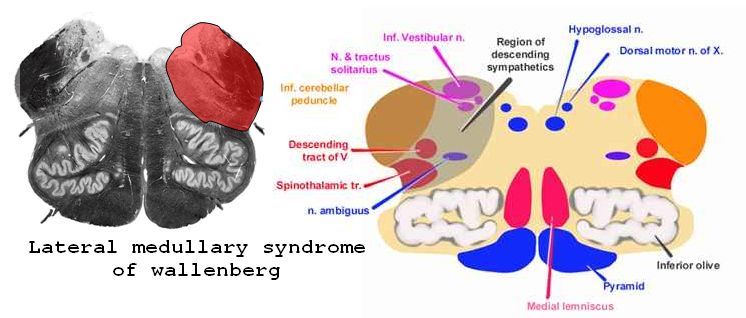lateral medullary infarction (Wallenberg syndrome)
Wallenberg described the first case in 1895

Wallenberg syndrome is also known as lateral medullary syndrome and posterior inferior cerebellar artery syndrome. This neurological disorder is associated with a variety of symptoms that occur as a result of damage to the lateral segment of the medulla posterior to the inferior olivary nucleus. It is the most common posterior circulation ischemic stroke syndrome
Etiology
Wallenberg syndrome is caused most commonly by atherothrombotic occlusion of the vertebral artery, followed most frequently by the posterior inferior cerebellar artery, and least often, the medullary arteries. Hypertension is the most prevalent risk factor, followed by smoking and diabetes. Cerebral embolism is a less frequent cause of the infarction. The other important cause to remember is vertebral artery dissection, which may have risk factors including neck manipulation or injury, Marfan syndrome, Ehlers Danlos syndrome, and fibromuscular dysplasia. Vertebral artery dissection is the commonest cause of Wallenberg syndrome in younger patients
Epidemiology
It can be estimated that there are more than 60,000 new cases of Wallenberg syndrome each year in the United States.
Presentation suggests right—sided lateral medullary infarction (Wallenberg syndrome)
Vestibulocerebellar symptoms
- Nystagmus (both horizontal and rotational),
- Vertigo with falling to the side of the lesion, and difficulty sitting upright without support.
Sensory symptoms
- loss of pain and temperature in the ipsilateral face (spinal trigeminal nucleus and tract) and contralateral trunk/limbs (spinothalamic tract).
- Despite the loss of sensation, pain in the face is sometimes prominent, also likely due to spinal trigeminal nucleus and tract lesions.
Ipsilateral bulbar muscle weakness
(eg, dysphagia, dysarthria, hoarseness) due to involvement of the nucleus ambiguus
Autonomic dysfunction
(eg, ipsilateral Horner syndrome). The corneal reflex may be diminished due to disruption of the spinal trigeminal nucleus (located within the lateral medulla), which interrupts the reflex pathway.
Treatment / Management
1-Ogawa K, Suzuki Y, Oishi M, Kamei S. Clinical study of 46 patients with lateral medullary infarction. J Stroke Cerebrovasc Dis. 2015 May;24(5):1065-74. [PubMed]
2.
Lui F, Tadi P, Anilkumar AC. StatPearls [Internet]. StatPearls Publishing; Treasure Island (FL): Jul 4, 2022. Wallenberg Syndrome. [PubMed]
3.
Amarenco P, Hauw JJ. [Anatomy of the cerebellar arteries]. Rev Neurol (Paris). 1989;145(4):267-76. [PubMed]
4.
Inamasu J, Nakae S, Kato Y, Hirose Y. Clinical Characteristics of Cerebellar Infarction Due to Arterial Dissection. Asian J Neurosurg. 2018 Oct-Dec;13(4):995-1000. [PMC free article] [PubMed]
5.
Park MG, Choi JH, Yang TI, Oh SJ, Baik SK, Park KP. Spontaneous isolated posterior inferior cerebellar artery dissection: rare but underdiagnosed cause of ischemic stroke. J Stroke Cerebrovasc Dis. 2014 Aug;23(7):1865-70. [PubMed]
6.
Saleem F, M Das J. StatPearls [Internet]. StatPearls Publishing; Treasure Island (FL): Aug 11, 2021. Lateral Medullary Syndrome. [PubMed]
7.
Hong YH, Zhou LX, Yao M, Zhu YC, Cui LY, Ni J, Peng B. Lesion Topography and Its Correlation With Etiology in Medullary Infarction: Analysis From a Multi-Center Stroke Study in China. Front Neurol. 2018;9:813. [PMC free article] [PubMed]
8.
Kim JS, Caplan LR. Clinical Stroke Syndromes. Front Neurol Neurosci. 2016;40:72-92. [PubMed]
9.
Caplan LR. Lacunar infarction and small vessel disease: pathology and pathophysiology. J Stroke. 2015 Jan;17(1):2-6. [PMC free article] [PubMed]
10.
Ferbert A, Brückmann H, Drummen R. Clinical features of proven basilar artery occlusion. Stroke. 1990 Aug;21(8):1135-42. [PubMed]
11.
Kim YK, Schulman S. Cervical artery dissection: pathology, epidemiology and management. Thromb Res. 2009 Apr;123(6):810-21. [PubMed]
12.
Saber Tehrani AS, DeSanto JR, Kattah JC. Neuroimaging "HINTS" of the Lateral Medullary Syndrome. J Neuroophthalmol. 2017 Dec;37(4):403-404. [PubMed]
13.
Chen K, Schneider AL, Llinas RH, Marsh EB. Keep it simple: vascular risk factors and focal exam findings correctly identify posterior circulation ischemia in "dizzy" patients. BMC Emerg Med. 2016 Sep 13;16(1):37. [PMC free article] [PubMed]
14.
De Cocker LJ, Lövblad KO, Hendrikse J. MRI of Cerebellar Infarction. Eur Neurol. 2017;77(3-4):137-146. [PubMed]
15.
Makin SD, Doubal FN, Dennis MS, Wardlaw JM. Clinically Confirmed Stroke With Negative Diffusion-Weighted Imaging Magnetic Resonance Imaging: Longitudinal Study of Clinical Outcomes, Stroke Recurrence, and Systematic Review. Stroke. 2015 Nov;46(11):3142-8. [PMC free article] [PubMed]
16.
Kumral E, Kisabay A, Ataç C, Calli C, Yunten N. Spectrum of the posterior inferior cerebellar artery territory infarcts. Clinical-diffusion-weighted imaging correlates. Cerebrovasc Dis. 2005;20(5):370-80. [PubMed]
17.
Salerno A, Cotter BV, Winters ME. The Use of Tissue Plasminogen Activator in the Treatment of Wallenberg Syndrome Caused by Vertebral Artery Dissection. J Emerg Med. 2017 May;52(5):738-740. [PubMed]
18.
Malik MT, Kenton Iii EJ, Vanino D, Dalal SS, Zand R. Lateral Medullary Ischemic Infarct Caused by Posterior Inferior Cerebellar Artery Aneurysm. Case Rep Neurol. 2017 Sep-Dec;9(3):316-319. [PMC free article] [PubMed]
19.
Nesbitt J, Moxham S, Ramadurai G, Williams L. Improving pain assessment and managment in stroke patients. BMJ Qual Improv Rep. 2015;4(1) [PMC free article] [PubMed]
20.
Meschia JF, Bushnell C, Boden-Albala B, Braun LT, Bravata DM, Chaturvedi S, Creager MA, Eckel RH, Elkind MS, Fornage M, Goldstein LB, Greenberg SM, Horvath SE, Iadecola C, Jauch EC, Moore WS, Wilson JA., American Heart Association Stroke Council. Council on Cardiovascular and Stroke Nursing. Council on Clinical Cardiology. Council on Functional Genomics and Translational Biology. Council on Hypertension. Guidelines for the primary prevention of stroke: a statement for healthcare professionals from the American Heart Association/American Stroke Association. Stroke. 2014 Dec;45(12):3754-832. [PMC free article] [PubMed]
21.
Yuan MZ, Li F, Tian X, Wang W, Jia M, Wang XF, Liu GW. Risk factors for lung infection in stroke patients: a meta-analysis of observational studies. Expert Rev Anti Infect Ther. 2015;13(10):1289-98. [PubMed]
22.
Guler A, Karbek Akarca F, Eraslan C, Tarhan C, Bilgen C, Kirazli T, Celebisoy N. Clinical and video head impulse test in the diagnosis of posterior circulation stroke presenting as acute vestibular syndrome in the emergency department. J Vestib Res. 2017;27(4):233-242. [PubMed]
23.
Roley SS, DeLany JV, Barrows CJ, Brownrigg S, Honaker D, Sava DI, Talley V, Voelkerding K, Amini DA, Smith E, Toto P, King S, Lieberman D, Baum MC, Cohen ES, Cleveland PA, Youngstrom MJ., American Occupational Therapy Association Commission on Practice. Occupational therapy practice framework: domain & practice, 2nd edition. Am J Occup Ther. 2008 Nov-Dec;62(6):625-83. [PubMed]
24.
Gupta H, Banerjee A. Recovery of Dysphagia in lateral medullary stroke. Case Rep Neurol Med. 2014;2014:404871. [PMC free article] [PubMed]
25.
Ekechukwu END, Olowoyo P, Nwankwo KO, Olaleye OA, Ogbodo VE, Hamzat TK, Owolabi MO. Pragmatic Solutions for Stroke Recovery and Improved Quality of Life in Low- and Middle-Income Countries-A Systematic Review. Front Neurol. 2020;11:337. [PMC free article] [PubMed]



